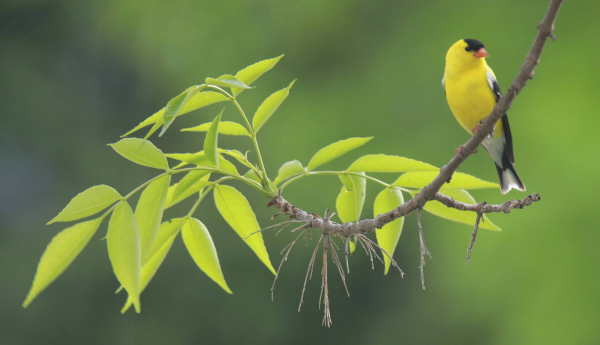
So often when photographing birds we want to get as close as possible, to take photos that show as much detail in a bird as we can and minimize the surrounding elements in a given photo. But sometimes we just can’t get any closer, and that’s when it’s worthwhile to get the most out of the situation and the bird before us, and that’s what happened when I spied a spritely colored American Goldfinch perched outside my office window. I reached for my camera, and zeroed in on the bird, magnifying it as much as possible while minimizing its surroundings.
After taking the first couple photos, the goldfinch was abiding enough to stay in its rather attractive position on the edge of an elm branch with brand new leaves stretching to one side. That’s when I realized there was a much better composition option before me. In response I reduced the magnification on my zoom lens to expand the view to the side of the goldfinch that included the entire leaf cluster. By using an f-6 aperture, I narrowed the area in focus so the background beyond the bird, branch, and leaves was blurred into pleasant shades of spring green. This not only eliminated the busy background, but it helped to emphasize the bird and leaves as a singular entity in the expanded image.
I always like to position the bird in the photo frame to one side, rather than centering the bird; and in this case it really adds a creative touch to the image. Now the photograph resembles more of an artwork, similar to what you might see in a Robert Bateman painting. This is an example of how we should look for other ways to compose a photograph of a bird beyond centering it, beyond our first impression. It’s something to keep in mind as you photograph a bird that provides a little extra time for you to think twice and consider some more creative photo composition options.
Article and Photograph by Paul Konrad
Share your bird photos and birding experiences at editorstbw2@gmail.com